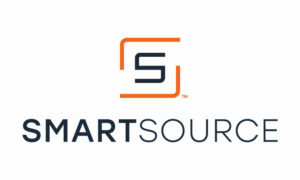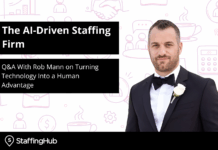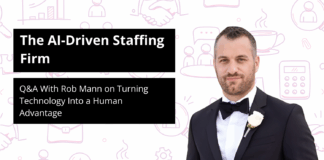
Sponsored by SmartSource


In today’s competitive staffing landscape, the difference between market leaders and those struggling to scale often comes down to operational efficiency — and nothing impacts efficiency more than IT infrastructure. While many staffing executives view technology as a necessary cost of doing business, forward-thinking leaders are discovering how the right IT strategy can become a powerful differentiator.
We sat down with Tom Boccard, Executive Vice President of Sales at SmartSource, to explore the hidden operational drags that are silently eroding staffing firms’ productivity and revenue. With decades of experience helping organizations strengthen operations and scale smarter, Tom works closely with staffing firms to align their IT infrastructure with business growth objectives.
Our conversation covers the “silent delays” that compound into significant revenue loss, the IT pitfalls that trip up fast-growing firms, and why the most successful staffing organizations treat IT as a growth enabler rather than an afterthought. From credentialing bottlenecks to endpoint management challenges, Tom shares practical insights on building scalable IT foundations that support everything from recruiter productivity to compliance requirements — and ultimately, bottom-line results.
Q. Where are staffing leaders underestimating the operational drag of slow IT, mismanaged hardware, or disconnected systems, especially as it impacts recruiters and onboarding teams?
Tom Boccard: Too often, leaders underestimate just how much tech friction recruiters and onboarding teams face daily. That might be slow logins, unstable virtual desktops, or clunky integrations between ATS and HRIS systems. These inefficiencies slow down everything, from candidate outreach to placement and onboarding. This translates into missed revenue opportunities and recruiter burnout. Staffing IT leaders need to be able to respond swiftly. For example, they should be able to deploy new software en masse.
Q. What’s an example of a “silent delay” that compounds and hits revenue — but doesn’t show up on a dashboard?
TB: One area of silent delay we see and work with companies to overcome is credentialing delays. For example, if a healthcare staffing firm’s systems can’t quickly verify licenses or push onboarding documents in a centralized way, it can stall placements by days. That’s not popping up on the dashboards, but if you multiply that by a couple or dozens of candidates per week, it adds up to significant lost revenue.
Q. In a decentralized or branch-heavy organization, what tends to break down first from an IT readiness standpoint?
TB: What we see the most is endpoint management. Remote locations will start using inconsistent hardware, insecure Wi-Fis, or unsupported devices. Without centralized IT visibility and control, it’s really hard to push updates, enforce security policies, or support remote troubleshooting. That’s what opens the doors to downtime and, equally or even more importantly, to compliance risk.
Q. You’ve worked with some of the largest staffing firms — what separates the operations teams that scale well from those that stall out?
TB: The ones that scale and have done so successfully are the ones that invest early in IT standardization and automation. They’re viewing IT as an enabler, not an afterthought. They have strong operations teams, and they partner closely with their IT provider to streamline onboarding, as well as to automate device provisioning and standardize workflows across the locations.
Teams that stall are often trying to scale on top of a weak foundation.
Q. In fast-growth environments, where do you recommend leaders start when they want to de-risk IT and accelerate onboarding?
TB: You have to start with provisioning and identity access management. Ask yourself, “Can you deploy a secure device and fully onboard new talent, no matter where they are, in under 48 hours?” That’s the benchmark that you have to look at.
Investing in tools like zero-touch deployment and single sign-on (SSO) makes a huge difference in both security and time to productivity.
Q. Compliance and co-employment are always lurking — where do you see firms getting burned, and how are smart teams avoiding it?
TB: We’ve seen firms get burned by inconsistent document retention and mismanaged user access. Smart teams are centralizing document management, automating retention policies, and tightly controlling who can access sensitive data. Of course, IT plays a major role here, ensuring that systems are continually updated with the latest security patches and are configured to support compliance from the start.
It’s when you’re playing catch-up that things start to get hairy. If you address it early, then it’s much easier, and you have much less risk creeping in from a compliance standpoint.
Q. What’s one strategic blind spot you see in how staffing executives think about IT and operational agility?
TB: It’s often short-term thinking. It’s fixing immediate issues instead of investing in scalable systems.
For the fast-growing firms that we’ve worked with, the ones that have moved beyond growth to market leaders, IT is a part of their growth conversations, and it starts early.
Going back to the shaky infrastructure, if it’s not built to scale securely and with flexibility, it will become your bottleneck.
Q. Let’s say a firm’s growing fast, adding offices, or expanding remote teams — what’s the biggest trap they fall into?
TB: Especially with the fast-growing firms out there, whether they’re adding offices or just expanding remotely, a big trap that we see is when they try to copy and paste their HQ setup into every new location and not account for local needs or scale variances. Or worse, they let each office figure it out on its own. That’s what creates tech sprawl, support issues, and compliance gaps.
The key is having a scalable, cloud-based IT foundation that’s centrally managed but locally responsive.
Q. If a CXO came to you asking how to improve time-to-productivity for new hires, where would you tell them to focus?
TB: I would tell them to look at the first week experience. How quickly can a new hire log in, access the right tools, and start working? Evaluate if they’re spending their time on paperwork or being trained and productive.
The fastest way to move that needle is to streamline device setup, access permissions, and onboarding workflows through automation.
Q. Looking ahead — how do you see the role of IT shifting in staffing organizations over the next two to three years?
TB: Obviously, IT is different from two to three years ago. There’s a lot more that can be done remotely and managed centrally, which is huge. Being able to manage it centrally has decentralized organizations, but in a safe, secure environment.
So, I think the role that IT plays in staffing moving forward will be the speed of onboarding. Anything from permanent placements to part-time or contractual work is about how quickly they can get onboarded and start working, as opposed to dealing with setups.
And this will transfer not just to people being able to log in and everything works, but the training, development, and onboarding aspects will be tied into that. Because the quicker you get people into their jobs, doing the tasks they’ve been hired to do, the quicker that ROI is happening across the board. It’s the ability to support people at any level — whether it’s return to office, increased hybrids or remote, or expanded offices — and knowing that it’s going to be the same everywhere and secure.
The speed-to-productivity aspect, where IT plays a greater role in onboarding and development, will have a huge impact. Security is at the forefront of all of that.
Q. As far as IT leadership in staffing, what qualities do you think that leaders today are going to need to be successful versus what IT staffing leaders looked like five years ago?
TB: Five years ago, IT was delivering a need. It was the cost of doing business. Now, it’s an enabler for growth.
To an IT leader within a staffing firm who sees around the corner, it’s a huge differentiator in a highly competitive field if they can have that growth orientation in the services they deliver. Not just to separate their firm from the other staffing firms, but to better support their clients on the other end.
For some of the firms looking to move into other aspects of staffing, the people they’re placing need to show up with their own software and hardware because the client doesn’t provide it. Staffing firms should ask, “How can that be an advantage for us? How can that be a new revenue stream for us?” From an IT leader perspective, having that growth mindset is going to become a must.
Q. Are there any other closing thoughts you’d like to share with our audience?
TB: It’s been interesting over the past couple of years to see how — even with the retraction that’s happened since COVID — there’s even more opportunity in IT. The shift to remote work created significant cybersecurity challenges for organizations, particularly the need for stronger security protocols and better protection of home-based computers. This created a greater awareness and increased adoption of comprehensive security solutions. It’s exciting to watch this industry stay at the forefront, on the bleeding edge, of all the developments happening in software, hardware, and security.
At the end of the day, the customer is what’s most important. And being able to bring them different solutions that protect their businesses and make their lives easier so they can do what they’re paid to do — rather than managing staffing or the tech that comes along with them — makes all the difference in the world.
To learn more about IT solutions in staffing and how a trusted tech partner can support your agency’s growth, reach out to SmartSource.





